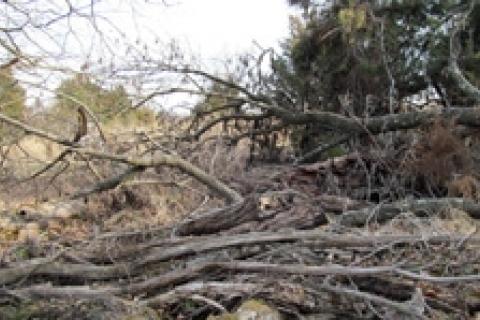
With just a bit of work, you can create a sanctuary that will draw and hold older bucks on your property. And if you don't make one, or don't already have one on the land you hunt, they will find one elsewhere when the hunting pressure builds. They need it for security and survival.
 |
| To make a sanctuary on your hunting land, all you need is a chainsaw and some safety equipment. |
Odds are good that there's somewhere on the land you hunt that almost fits the needs already for a buck sanctuary. It may just take a little extra work to put the final touches on it, or you may have to basically build it yourself. It's not a hard or expensive project in either case.
One sanctuary is adequate for 75 to 150 acres. For larger parcels, you may want two sanctuaries. Anywhere from five to 30 or more acres could be involved. It all depends on the topography and thickness of the vegetation.
To complete the job all you need is a chain saw and safety equipment, a shovel and some pine seedlings or young trees.
The first step is to locate the best spot. The most useful sanctuaries are in remote, hard-to-reach areas where rough or swampy habitat discourages humans from entering. Study a topo and aerial photograph of your land and then scout to find the best spot that fits these needs, preferably near the middle of the property.
Heads of draws, mountain benches, brushy hollows or overgrown marshes are great spots. Shrubs, bushes, saplings and greenbrier offer food and cover and make the spot even better.
The second step is to cut some trees. Fell a number of low-quality trees in the area for bucks to bed up against. That gives them security cover, protection from wind and also tender branch tips they can browse on.
Cut some of these only partially through — just enough so they fall but remain attached to the stump and roots. These will live for another year or two in some cases, providing even more browse.
Also fell several trees in clusters, so they fall at angles on top of one another. This provides high-stacked cover so a large buck can hunker down in the jungle and have his tall rack hidden.
The third step is to plant evergreens. Depending on how much cover is present, you may or may not need this step. Putting in some fast-growing pines or other evergreens, though, will provide a wind break and shelter from storms, drawing bucks in to your sanctuary. Plant them 8 to 10 feet apart in clusters of one half to two acres.
The fourth and final step is simple: Do not disturb. The main thing that makes or breaks a sanctuary is whether you truly respect the meaning of that word. Stay out except to retrieve a hit deer or maybe to search for sheds in spring. You want the biggest buck in the area to feel this is the spot where he needs to be to survive.
Give him that and he'll stay put. Then next fall, when he's even bigger and you catch him outside the sanctuary chasing a doe, you'll get your chance.
- 2690 views

